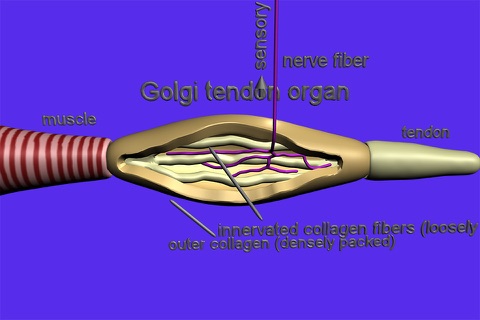
Senses of Touch, Vibration and Proprioreception app for iPhone and iPad
Muscle spindle structure and function - static and dynamic response
First we enter a 3D muscle model showing the location of the muscle spindle. Then we pass to another scene about the anatomy and function of the quite complex way the muscle spindle responds to different ways of movement of the muscle. Therefore there are two scenes: one describing the response in case of the slow muscle movement and the other explains what happens in case of the fast extension or flexion of the muscle.
Golgi tendon organ - a mechanoreceptor in the muscle tendon
In our project we first show in a 3D muscle model, where the muscle spindle and the Golgi tendon organ are located. Then we look more closely at the Gol- gi tendon organ, revealing its internal structure - the outer compact collagen sheath and the inner loose- ly packed collagen fibres and the nerves innervating them.
Skin structure (skin layers and sensory structures)
We explain the skin structure in a highly animated VR scene. At first the user sees the 3D model of the skin segment in with all its layers and organs. Then the animation starts - the skin layers bend and peel off one after the other so that the complex structure becomes more easily observed and understood. This animation can be paused at any time (or even run backwards from that point) and of course - since this is a virtual reality world - the user can study the “exploded” skin segment from any angle or distance.
The next scene is about the Pacinian corpuscle. This is a mechanoreceptor, especially good for sensing the bvibration. The first view shows the Pacinian corpuscle as a whole, with the myelinated nerve protruding downwards. Then the outer sheath disappears and we see many concentric sheaths enveloping the free nerve ending, which is the place where mechanical stimulus is translated into the nerve excitations. As the sheaths of the corpuscle get deformed during the animation, the nerve gets excited and coloured nerve impulses travel down along the sensory nerve.



